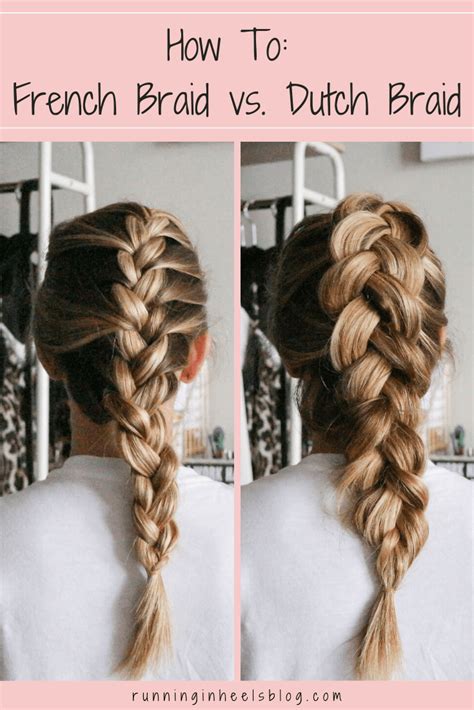Braiding, an intricate art form that has been passed down through generations, is a versatile way to create elegant and intricate hairstyles. Among the numerous braiding techniques, two stand out as timeless classics: the French braid and the Dutch braid. Each with its own unique charm and versatility, these braids can elevate any look, from everyday casual to formal occasions.

Understanding the Differences: French Braid vs. Dutch Braid
1. Technique:
- French braid: Three strands are used to create an intricate basket weave pattern, with new hair added as you go.
- Dutch braid: Also known as an “inside-out” braid, the Dutch braid follows the same three-strand process as the French braid, but the strands are crossed under each other instead of over.
2. Appearance:
- French braid: Characterized by its delicate, rope-like appearance with strands interwoven to create a seamless braid.
- Dutch braid: Exhibits a raised, textured look, with the strands standing out prominently.
3. Hair Type:
- French braid: Generally suitable for all hair types, from fine to coarse.
- Dutch braid: Ideal for thicker hair that is less prone to tangling or knotting.
Choosing the Right Braid for Your Style
Selecting the appropriate braid for your desired look depends on several factors:
1. Hair Volume and Thickness: Thick hair suits the bold texture of a Dutch braid, while finer hair might appear more delicate in a French braid.
2. Occasion: For formal events or special occasions, the intricate elegance of a French braid is a timeless choice. For a more casual or bohemian vibe, the textured Dutch braid is an excellent option.
3. Face Shape: A French braid can help elongate an oval or round face, while a Dutch braid can add width to a narrow face.
Step-by-Step Braiding Guide
French Braid:
- Divide damp or dry hair into three equal sections.
- Cross the right strand over the middle strand.
- Cross the left strand over the new middle strand (formerly the right strand).
- Pick up a small section of hair from the left side and add it to the left strand.
- Cross the enhanced left strand over the new middle strand (formerly the right strand).
- Repeat steps 4-5 on the right side.
- Continue braiding until all hair is used up.
- Secure the braid with an elastic band or ribbon.
Dutch Braid:
- Divide hair into three equal sections.
- Cross the right strand under the middle strand.
- Cross the left strand under the new middle strand (formerly the right strand).
- Pick up a small section of hair from the left side and add it to the left strand.
- Cross the enhanced left strand under the new middle strand (formerly the right strand).
- Repeat steps 4-5 on the right side.
- Continue braiding until all hair is used up.
- Secure the braid with an elastic band or ribbon.
Why Braiding Matters: Benefits of French and Dutch Braids
Beyond their aesthetic appeal, French and Dutch braids offer several benefits:
1. Styling Versatility: Braids can be worn down, up, or in various updos, allowing for endless styling possibilities.
2. Hair Health: Braiding helps distribute natural oils throughout the hair, promoting hair growth and conditioning.
3. Tame Frizz: Braids help control unruly or frizzy hair, keeping it smooth and manageable.
4. Time-Saving: Braids can be a quick and easy way to style hair, especially on busy mornings or when time is limited.
5. Protective Styling: Both French and Dutch braids can be used as protective styles, shielding hair from damage caused by heat styling or harsh environmental factors.
Creative Applications of French and Dutch Braids
The versatility of French and Dutch braids extends beyond traditional hairstyles. Here are a few innovative ideas for incorporating braids into your routine:
1. Braid Headbands: Create a chic and functional headband by braiding two sections of hair from each side of the head and securing them at the back with hairpins.
2. Braided Bangs: Braid the front portion of your bangs to keep them out of your face while adding a touch of style.
3. Braided Jewelry: Weave strands of beads, ribbons, or charms into your braids to create unique and eye-catching accessories.
4. Braided Bun: Gather your hair into a high ponytail and braid it, then wrap the braid around the base of the ponytail to form a stylish bun.
Effective Strategies for Mastering French and Dutch Braids
1. Practice Makes Perfect: The key to mastering braiding is consistent practice. Start by experimenting on a friend or family member before attempting it on yourself.
2. Section Your Hair: Divide your hair into smaller sections to make the braiding process easier and more precise.
3. Use a Wide-Toothed Comb: A wide-toothed comb helps prevent tangles and snags while braiding.
4. Keep Your Strands Tight: Avoid pulling your strands too tightly, which can cause breakage. But make sure they’re tight enough to hold the braid securely.
5. Don’t Be Afraid to Experiment: Once you’ve mastered the basic French and Dutch braids, experiment with different variations, such as fishtails, cornrows, or combination braids.
Conclusion
French braids and Dutch braids are timeless braiding techniques that offer endless styling possibilities. Understanding the differences between each type allows you to choose the perfect braid for your hair type and desired look. By following the step-by-step instructions and implementing effective strategies, you’ll become an expert at creating beautiful and flattering braids. So, next time you’re looking for a stylish and versatile hairstyle, consider the timeless charm of a French or Dutch braid.
